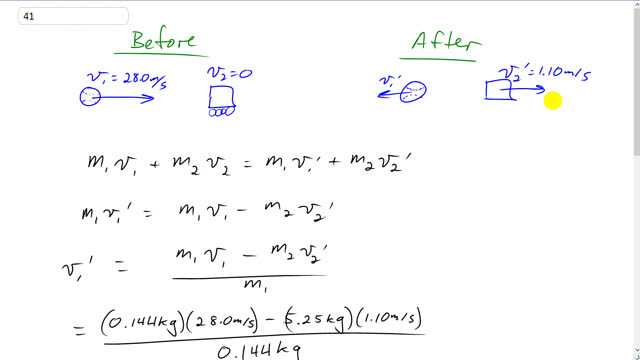
A 144-g baseball moving 28.0 m/s strikes a stationary 5.25-kg brick resting on small rollers so it moves without significant friction. After hitting the brick, the baseball bounces straight back, and the brick moves forward at 1.10 m/s.
- What is the baseball’s speed after the collision?
- Find the total kinetic energy before and after the collision.

In order to watch this solution you need to have a subscription.
This is Giancoli Answers with Mr. Dychko. This baseball is approaching a brick which is initially at rest and the baseball has a velocity of 28.0 meters per second. And after the collision, we are told that the brick is moving to the right with a speed of 1.10 meters per second and the baseball rebounds with some speed that we have to figure out. So momentum is conserved and the v 2 being zero means that this term disappears— this is total momentum before the collision equals total momentum after the collision— and that means m 1v 1 prime equals m 1v 1 minus m 2v 2 prime when we move this term to the left side and then switch the sides around and then we can divide both sides by m 1 to solve for v 1 prime— velocity of the baseball after the collision. And we get v 1 prime is m 1v 1 minus m 2v 2 prime all over m 1. So plug in some numbers and we get mass of the baseball is 0.144 kilograms— we have to convert from grams into kilograms— and then times that by 28.0 meters per second minus the mass of the brick—5.25 kilograms— times its velocity after the collision— 1.10 meters per second— and divide by mass of the ball— 0.144 kilograms— and that gives negative 12.1 meters per second so that means the ball is going to the left that's what the negative sign means. The question, technically, is asking us for the speed of the ball so we'll take the absolute value of that velocity and that gives us 12.1 meters per second. The total kinetic energy before collision is one-half m 1v 1 squared because the brick has no velocity so it has no kinetic energy so it's just the mass of the baseball times its speed squared times a half and that gives 56.4 joules of energy. After the collision, we take the one-half times the mass of the ball times its speed after collision squared plus one-half mass of the brick times its speed after the collision squared and that's 0.5 times 0.144 kilograms times negative 12.104 meters per second squared plus one-half times 5.25 kilograms times 1.10 meters per second squared and that gives 13.7 joules. So this collision was, to some extent, inelastic because some kinetic energy was lost.
Why is this collision deemed "inelastic" in terms of the treatment of kinetic energy conservation. Seems based on the diagram, the objects are not sticking together, which would suggest its inelastic.
Hi sheumangutman,
Thanks for the question. The term "inelastic" means there is less total kinetic energy after a collision compared with before a collision. Since that's the case here, we can call it inelastic. It is not "completely inelastic", that's true. A completely inelastic collision involves the two particles sticking together, and this type of collision results in the maximum loss in kinetic energy that's possible while still conserving momentum. Seeing two particles bounce apart means either the collision is "inelastic" (but not "completely inelastic"), or maybe the collision is "perfectly elastic", in which case the total kinetic energy after collision is the same as it was before. In this case, the collision is a regular inelastic collision since some kinetic energy was lost, but not the maximum loss that would have otherwise been possible had they stuck together.
Best,
Mr. Dychko